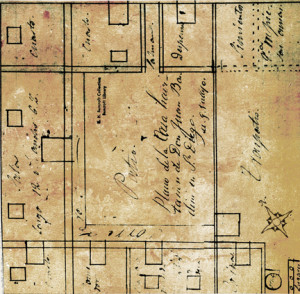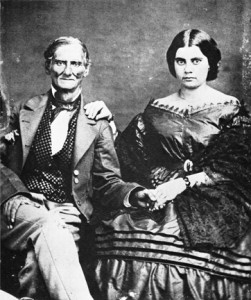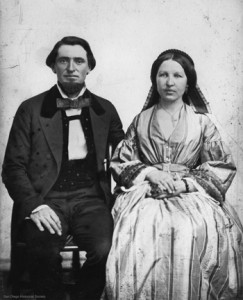History
These Walls Have a Story to Tell.

Imagine Old Town San Diego in the 1830s – no trees, no grass, no wooden buildings – just a handful of adobe homes scattered around a dry, dusty plaza. Between 1827 and 1829, Juan Bandini had a U-shaped home built off one corner of the plaza. Compared to most of the other modest adobes, Casa de Bandini was a grand mansion and the social center of town. The rooms had thick, insulating adobe walls. The ceilings were covered on the inside with heavy muslin to trap insects, dirt and straw that fell from the thatch roof.
Construction of the casa was a colossal undertaking. It contains an estimated 10,000 adobes bricks, weighing as much as 60 pounds each. The foundation, made of large round river rocks, rose four and a half feet above ground at the corner facing the plaza. The heavy labor was most likely performed by Christianized Indians hired from the local mission.
Imagine Old Town San Diego in the 1830s – no trees, no grass, no wooden buildings – just a handful of adobe homes scattered around a dry, dusty plaza. Between 1827 and 1829, Juan Bandini had a U-shaped home built off one corner of the plaza. Compared to most of the other modest adobes, Casa de Bandini was a grand mansion and the social center of town. The rooms had thick, insulating adobe walls. The ceilings were covered on the inside with heavy muslin to trap insects, dirt and straw that fell from the thatch roof.
Construction of the casa was a colossal undertaking. It contains an estimated 10,000 adobes bricks, weighing as much as 60 pounds each. The foundation, made of large round river rocks, rose four and a half feet above ground at the corner facing the plaza. The heavy labor was most likely performed by Christianized Indians hired from the local mission.

Bandini was known for his elegant dress and gracious demeanor. He was said to be a charming public speaker, fluent writer, fair musician and fine horseman. However, Juan Bandini and his home are most fondly remembered for hosting grand week-long fandangos or dance parties. Richard Henry Dana, Jr., an American who visited San Diego in the 1830s, wrote in Two Years Before the Mast, “Bandini…gave us the most graceful dancing that I had ever seen. His slight and graceful figure was well calculated for dancing, and he moved about with the grace and daintiness of a young fawn. An occasional touch of the toe to the ground seemed all that was necessary to give him a long interval of motion in the air. He was loudly and repeatedly applauded, the old men and women jumping out of their seats in admiration, and the young people waving their hats and handkerchiefs.”
After the United States wrested control of California from Mexico in the 1840s, many Californios struggled to adapt to the rapid and dramatic shift from a Mexican cattle ranching economy to an American merchant-based economy, and Juan Bandini was no exception. Throughout the 1850s his wealth and health faded. In 1859 he sold his beloved home in an effort to pay off debts and died just months thereafter.

In 1869, American stagecoach operator, Albert Seeley purchased the dilapidated home for $2,000 in gold coin with plans to build a stagecoach stop and hotel. His wife, Emily, had recently inherited $8,000, which was used to build a second story, modeled in a Greek revival theme. The second story was well constructed but not actually attached to the lower adobe level – it just rested on top of the adobe walls! The Seeleys also enlarged the downstairs parlor in order to serve meals and to provide a gathering place for guests. The building featured a saloon, sitting room, billiards room, barber shop and post office. The Cosmopolitan Hotel’s main attraction was its balcony that wrapped around the second story, a grandstand from which guests enjoyed watching a variety of amusements on the plaza, such as Fourth of July celebrations, mule team races, circuses and even bull and bear fights.
By the early 1870s, Albert and Emily’s social standing rose and the building once again became the social center of town. The room was the scene of galas, balls, dances, raffles, family reunions and weddings. Imagine bellying up to the bar, sipping the choicest wines and liquors, and puffing on a fine Havana cigar (which you paid a mere 20 cents for).
As the railroads spread, Seeley’s stagecoach operation gradually became obsolete. A tragic fire on the opposite side of the plaza sealed Old Town’s fate. The social, political, and cultural center of San Diego shifted from Old Town to the newly establish New Town (The Gaslamp Quarter of today’s downtown). Seeley sold the building in 1888, and it once again fell into disrepair.


